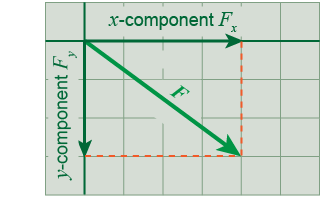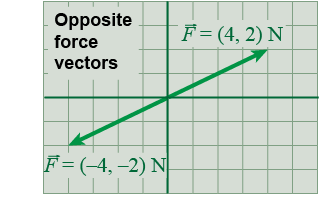|
Our last example points to a very powerful approach to working with vectors. A resultant 5 N force at −36.9° has the same effect as the combination of a 4 N force in the x-direction and a −3 N force in the y-direction. It is much easier to work with forces along the x- and y-axes than to work with forces at arbitrary angles. Forces along the x-, y-, or z-axis that together represent another force are called components. In this example, the component along the x-axis is a 4 N force, which is also called the x-component. The −3 N force is the y-component because it is along the y-axis. Any vector, at any angle, can be resolved into its components. The easiest and most accurate way to add, subtract, and even multiply vectors is by performing the operations separately on the components of the vectors in each direction. 
|
 Consider an arbitrary force vector with magnitude F. The component force of the vector in the x-direction is Fx and is found by drawing a perpendicular line from the head of the vector to the x-axis. The y-component Fy is similarly found by drawing a perpendicular line to the y-axis. (For a three-dimensional vector there would also be a z-component Fz found in a similar way.) We write the total force vector by arranging the x-, y-, and z-components in the order (x, y, z) inside parentheses like equation (6.1).
Consider an arbitrary force vector with magnitude F. The component force of the vector in the x-direction is Fx and is found by drawing a perpendicular line from the head of the vector to the x-axis. The y-component Fy is similarly found by drawing a perpendicular line to the y-axis. (For a three-dimensional vector there would also be a z-component Fz found in a similar way.) We write the total force vector by arranging the x-, y-, and z-components in the order (x, y, z) inside parentheses like equation (6.1). 
|
| (6.1) | | | Fx | = | x-component of force (N) | | Fy | = | y-component of force (N) | | Fz | = | z-component of force (N) |
| Force vector
by components |
|
 The components of a force vector are also force vectors themselves, and they can have positive and negative values. For example, the force vector = (+4,+2) N points in the opposite direction from the vector = (−4,−2) N. When solving problems, draw a diagram to determine the sign of vector components. By using positive and negative values, a two-component (x, y) vector can describe all possible directions on a plane. The three-component (x, y, z) vector can uniquely describe all possible directions in space.
The components of a force vector are also force vectors themselves, and they can have positive and negative values. For example, the force vector = (+4,+2) N points in the opposite direction from the vector = (−4,−2) N. When solving problems, draw a diagram to determine the sign of vector components. By using positive and negative values, a two-component (x, y) vector can describe all possible directions on a plane. The three-component (x, y, z) vector can uniquely describe all possible directions in space. 
|
In this book, we are referring to components of a vector (e.g., ) as vector components, because they can take negative values and those negative values imply direction. This is reinforced graphically in order to make resolving vectors into their components very clear, such as in the first illustration on this page. 
 |
In more advanced courses in physics or mathematics, other notation is often used that makes it clear that the components of a vector are scalars, not vectors. In such notation unit vectors in the direction of each coordinate axis are used: The funny-looking, triangular “hats” on the top of the x, y, and z are the sign for unit vectors. The unit vector x̂ is a vector that is one unit long in the direction of the x-axis. In this notation, the components 6, −2, and 4 are all scalars, because they are then multiplied by a unit vector to create vector components in the direction of each of the three axes.
In this book, the component resolved along the y-axis (−2ŷ for this example) is called the vector component and is a vector quantity because it has direction. 
|
The process of breaking a force vector into its components is called resolution of forces. When a vector has been written in the form = (Fx, Fy), we say the vector has been resolved into its components. For two-dimensional problems such as this, only the x- and y-components are used. 
|
| |
|

